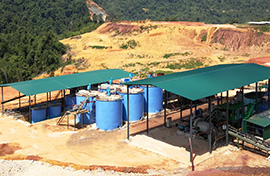-
 E-mail
guhaixin0724@gmail.com
E-mail
guhaixin0724@gmail.com
-
 Call Us
008613683147042
Call Us
008613683147042
 E-mail
guhaixin0724@gmail.com
E-mail
guhaixin0724@gmail.com
 Call Us
008613683147042
Call Us
008613683147042
2019-03-15 Views: 12007
Warm Tip: If you want to know more information, like quotation, products, solutions, etc., please Click here ,and contact us online.

Gold recovery chemicalsis the chemical that used to extract gold from ore. The commonly used gold recovery chemicals can be mainly divided into three types: flotation chemicals, heap leaching chemicals and CIL or CIP chemicals.
The mineral flotation process is to strengthen the hydrophobicity of useful minerals and the hydrophilicity of gangue minerals through a certain flotation chemical system. Under the action of mechanical agitation, the useful minerals are floated up to become concentrate, and the gangue minerals sink and become tailings. Through flotation process, the concentrate and tailings can be well separated. The main gold recovery chemicals to be added during the gold flotation process are: flotation collectors, flotation foaming agents and flotation conditioners.
How to select the proper type of flotation collectors for gold recovery varies from the nature of the ore?
In the flotation process of sulfide ore, xanthate, xanthate derivatives, aerofloat, benzoxazole thiol are commonly used collectors for gold recovery. In the flotation of oxided ore, fatty acids and its sodium soaps, alkyl sulfonates, alkyl sulfates, phosphates and arsenates are commonly used collectors. In addition, kerosene and diesel are generally used as oil flotation collectors for gold recovery chemicals.
In the gold flotation recovery process, foaming chemicals must be added to the slurry. Commonly foaming chemicals used are eucalyptus oil, camphor oil, cresylic acid, higher alcohols and No. 2 flotation oil (2# oil).
The flotation conditioners can be further classified into pH adjusting agent, activator, inhibitor, flocculating agent and dispersing agent depending on the function. The gold recovery chemicals like lime, sodium carbonate, sodium hydroxide and sulfuric acid are used for adjusting slurry pH; sodium sulfide is used for activation; water glass and phosphate are used for dispersion; flocculation and starch are used for flocculation.
The heap leaching method is mainly suitable for low grade gold ore recovery, with the average grade of gold ore is 0.7-1.5g/t. Heap leaching gold recovery process including 6 steps:
● Crush the ore to a certain particle size (-15mm);
● Convey it to the storage hopper;
● Adding gold ore, lime and binder according to the specified amount, mixing them thoroughly and conveying the gold ore to the disc granulator;
● After granulation, the gold ore is piled on the non-leakage ground (dip pad);
● Start pre-soaking with lime solution until the pH of the heap effluent reaches 9 to 11;
● Spray with NaCN solution or eco-friendly gold recovery chemicals with a concentration of 0.2 to 1.0 g/L.
When the solution slowly passes through the heap (diafiltration) from top to bottom, the gold will dissolve. At this time, the pregnant solution flowing out from the bottom surface is sent to precipitate the precious metal, and cyanide solution after gold removal or non-toxic lean solution is returned to the spray heap for recycling.
In summary, the heap leaching gold recovery chemicals are mainly sodium cyanide, potassium cyanide, environmentally friendly gold leaching reagent, lime solution and binder.
The CIL or CIP method uses an aqueous solution of an alkali metal cyanide as a solvent to leach gold, and then extracts gold from pregnant solution by using a zinc powder replacement device, carbon in pulp, or carbon in leaching method. Cyanide is an essential gold recovery chemical for CIL or CIP method. Commonly used cyanide agents are NaCN, KCN, NH4CN, and Ca(CN)2. Taking into account the relative solubility of cyanide to gold, stability, the impact of impurities on the process, the price and reliability of supply, NaCN is the most commonly used cyanide in the industry.
However, cyanide is a highly toxic gold recovery chemical, it has caused serious pollution to the environment during the gold recovery process, so cyanide has been banned in many countries. At present, eco-friendly gold recovery chemicals become more and more popular, that can completely replace cyanide, and has gradually become a new choice for many gold recovery plants. There are many manufacturers specializing in the production of eco-friendly gold recovery chemicals. CNLITE eco-friendly gold recovery chemicals are one of them. As an alternative to cyanide, CNLITE eco-friendly gold recovery chemical is characterized by a reduction in environmental pollution while ensuring leaching effect and leaching rate, and is therefore favored by many gold ore recovery plants.
In summary, in gold flotation process, the commonly used gold recovery chemicals are collectors (kerosene, diesel, fatty acids and their sodium soaps, alkyl sulfonates, alkyl sulfates, phosphates, arsenates), foaming agents (eucalyptus oil, camphor oil, cresol acid, higher alcohols and No. 2 flotation oil), and conditioning agents (lime, water glass, sulfuric acid). In gold heap leaching process, the commonly used gold recovery chemicals are sodium cyanide, potassium cyanide, eco-friendly gold recovery chemicals and lime. In CIL or CIP process, the commonly used gold recovery chemicals are sodium cyanide and eco-friendly gold dressing agent.
Of course, to choose which kind of gold recovery chemical for the gold recovery plant is still based on the properties of the gold ore itself, the project condition and government policies.
No. 188, Xinhai Street, high-tech Industrial Park, Fushan District, Yantai, Shandong, China.

Please leave your message here! We will send detail technical info and quotation to you!